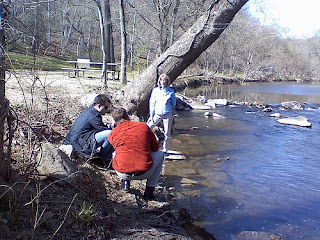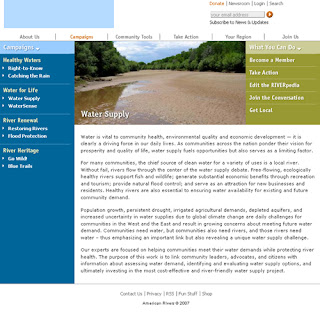For the last few weeks, our controlled group of 10 bloggers have been meeting and discussing what it means to blog. Yes, as I've been musing all along, we're attempting to define it for us.
These meetings have been a lot of fun, and productive, which is cooler. We've taken a look at who's blogging, how they're talking online, and what value we can add to the river conversation (we know it's already happening).
However, one of the issues that has surfaced is how will we protect ourselves from saying something...um, not so kind, or respectful, or productive, or (you fill in the word). Nothing new, but a very legitimate concern - presidential candidate John Edwards showed us that. Our discussion revealed that we needed to create guidelines for all *bloggers* to review prior to posting.
After a Google search, I found IBM and Yahoo!'s blogging policy/guidelines. This, combined with an internal email from our general counsel outlining immediate concerns and providing a few suggestions, I assembled our top 10 blogging do's and don'ts.
Here I go, our guide to successful blogging (what am I missing?) -
1. No Ad hominem attacks.
a. Not only does this reduce the chance of libel liability, but it avoids offending people you might want to work with in the future and it also keeps you from seeming wild-eyed and lacking in substance for your arguments.
This does not mean you can't attack actions by the administration or Congress—it's just the difference between saying "this week the Bush administration adopted a nasty proposal to do X" vs. "this week the nasty Bush administration adopted a proposal to do X".
2. Avoid imputing motives to other people.
a. Though supporters want to understand what is going on and why someone would add more sewage to water, we don't know what is in someone else's head—and it's best to avoid claiming we do.
But you can get these messages across by stating facts rather than imputing motives. Rather than saying "the Administrator Johnson wants to make it easier for big Republican donors to rip up wetlands," let's just say "big developers have been lobbying for more ability to rip up wetlands," which allows the reader to make the connections.
3. Write for everyone.
a. A blog is in many ways even more public than the front page of the Washington Post, so people should not assume the readership is anything more narrow than "everyone with a computer.” In fact, all words represent the organization and can be quoted by members of the media.
4. Be Respectful of Your Colleagues.
a. Be thoughtful and accurate in your posts, and be respectful of how other staff members, STAC, and supporters may be affected. All American Rivers employees can be viewed (correctly or incorrectly) as representative of the organization, which can add significance to your public reflections on the organization (whether you intend to or not).
5. Get Your Facts Straight.
a. To ensure you are not misrepresenting your fellow employees or their work, consider reaching out to a member of the relevant team before posting. This courtesy will help you provide your readers with accurate insights, if you’re blogging outside your area of expertise. If there is someone at American Rivers who knows more about the topic than you, check with them to make sure you have your facts straight.
6. Provide Context to Your Argument.
a. Provide enough support in your posting to help readers understand your reasoning, be it positive or negative. Help readers understand your perspectives by providing context to your opinion. Develop a thoughtful argument that extends well beyond “(insert) is cool” or “(insert) sucks”.
7. Engage in Private Feedback.
a. In order to maintain an open dialogue that everyone can comfortably engage in, welcome “off-blog” feedback from their colleagues who would like to privately respond, make suggestions, or report errors without having their comments appear on the blog. If you have an opinion, correction or criticism regarding a posting, reach out to the blogger directly.
8. No nondescript Posting Titles.
a. Users must be able to grasp the gist of an article by reading its headline. Avoid cute or humorous headlines that make no sense out of context. Descriptive headlines are especially important for representing our blog in search engines, newsfeeds (RSS), and other external environments.
Sample bad headlines:
* What Is It That You Want?
* Hey, kids! Comics!
* Victims Abandoned
Sample good headlines:
* Pictures from Die Hunns and Black Halos show
* Office Depot Pays United States $4.75 Million to Resolve False Claims Act Allegations (too long, but even if you only read the first few words, you have an idea of what it's about)
* Ice cream trucks as church marketing
9. Links Don't Say Where They Go (no acronyms).
a. One of the basics of the Web: Life is too short to click on an unknown. Tell people where they're going and what they'll find at the other end of the link.
Generally, you should provide predictive information in either the anchor text itself or the immediately surrounding words. You can also use link titles for supplementary information that doesn't fit with your content.
A related mistake in this category is to use insider shorthand, such as using first names or acronyms when you reference other writers, weblogs, organizations, or government agencies.
10. Read, write, and credit other bodies of work online.
a. One of the best ways to create readership is to cite other blog posts. Remember, this is an online conversation that requires active participation as a writer and reader. It is best to learn who is writing on your subject, what they’re saying, and how you can add value to the conversation.
As a general rule of thumb, if you write for an hour you should read and comment on other blogs for an hour. To learn who’s already talking about your subject area, visit www.technorati.com/ and www.blogsearch.google.com.
















































